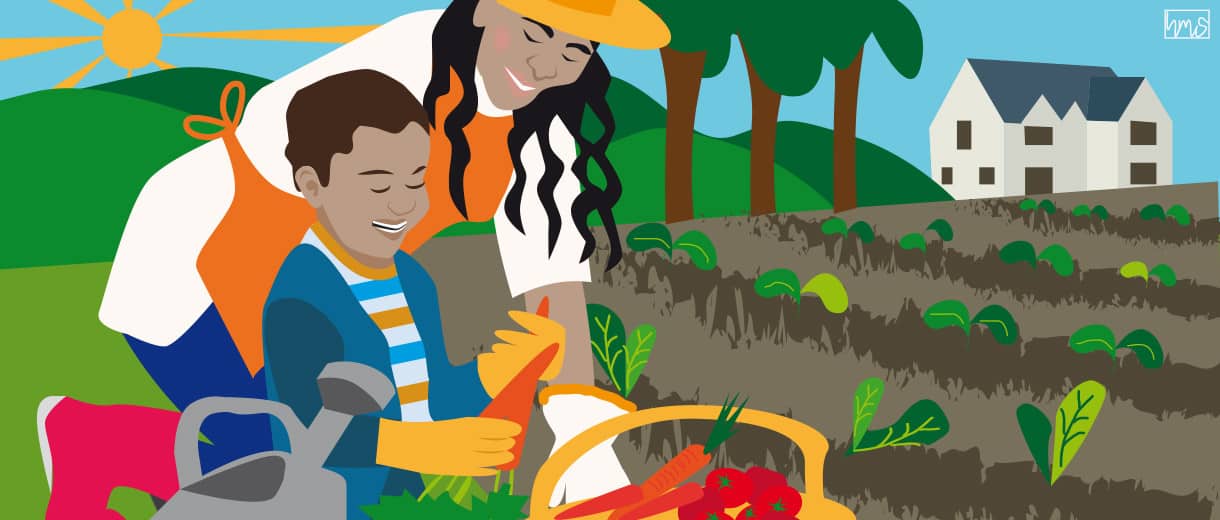Gardening With Kids: How To Keep Little Fingers Busy
Growing our own food is a rewarding experience, especially for kids. Seeing a seed slowly transform into their favourite fruit or vegetable is a fun and magical event for them. While that will keep them busy, it will also encourage your children to eat more of their ‘five a day‘, developing a much healthier relationship with what they eat. A gardening project can even foster an interest in science, improve socialising and interpersonal skills, and can quietly teach multiple skills such as perseverance, problems solving and individual responsibility.
How to get ‘little fingers’ into gardening
Kids are naturally curious, so it’s really just about stimulating that interest. Give your green-fingered little ones their own vegetable plot in the garden and encourage them to choose a variety of flowers, healthy vegetables, salads and herbs to plant, water and watch them grow. Helping your children to step away from their screens and get more involved in gardening will bring so many benefits to the whole family, and help our natural wildlife to thrive.
According to experts from the ‘Royal Horticultural Society‘ (RHS):
Experiencing success in growing plants as a child is often a person’s first memory of gardening. Give children their own positive experience by introducing them to some inspiring plants: easy flowers to grow from seed such as sunflowers, marigolds and poppies and sensory plants to play with like furry Stachys byzantina, smelly curry plant (Helichrysum italicum), lemon balm (Melissa officinalis) and chocolate cosmos (Cosmos atrosanguineus)
You can also keep them busy by planting a range of homegrown produce that will grow at different rates, so they have a constant crop of fresh food to harvest. Quick-growing runner beans, lettuce and carrots are great options to get started, while potatoes, radish and beetroots will provide a bounty of root veg that can be harvested later in the autumn.
What if you don’t have a proper garden?
One of the easiest ways to grow your own food, especially if you have smaller spaces, is through vertical or container gardening. Vertical greenery is perfect in areas where you have tiny gardens and is becoming more and more popular in urban areas where space is limited. Affordable upright frames can be bought pre-built, or you can create your own setup. Children would love the novelty planting strawberry and tomato (some of the best climbers you can grow on a vertical frame), hardy fuchsias and petunias which will provide months of vivid colour throughout the warmer season.
If you have a small deck or a patio or a rooftop plot, you can start your little container gardening project with a seed-starter kit: you can involve your kids in planting the seeds in trays or small pots (plastic cups, yoghurt pots or biodegradable pots), place them in the sunniest area possible and keep them moist. Basil, mint and rosemary, radishes, chillies, tomatoes and strawberries are just some of the delicious foods you can grow at home. Micro-leaves are all the rage and kids will love growing, and hopefully eating, them too. Fill your pots almost to the top with compost – just leave a little gap to make watering easier. Scatter the veg or herb seeds thinly across the surface, then cover with a little compost. Water to dampen the compost, then check them regularly to make sure it doesn’t dry out. To harvest the microgreens, simply snip them off at the base.
Kids will also enjoy creating a theme for their container garden, from cartoon characters to colours and textures. Try a fairy garden from ferns, or a mini-moss terrarium for dinosaurs. You can use upcycled glass jars, an old aquarium, or even old shoes. Grab one or two, along with a plastic sandwich bag. Fill the bag with soil and place a cutting, moisture-loving plant, inside such as pothos. Then, insert the planted baggie into the shoe and fold the top of the baggie over the top of the shoe. Spruce up the shoe’s exterior with fancy new shoelaces or paint.
Whatever container you choose, drainage holes are essential. Without drainage, the soil will become waterlogged and plants may die. Container gardening plants need also regular feeding: fertilise them once every two weeks by watering with coffee grounds or compost tea. Adjust the frequency depending on plant response.





